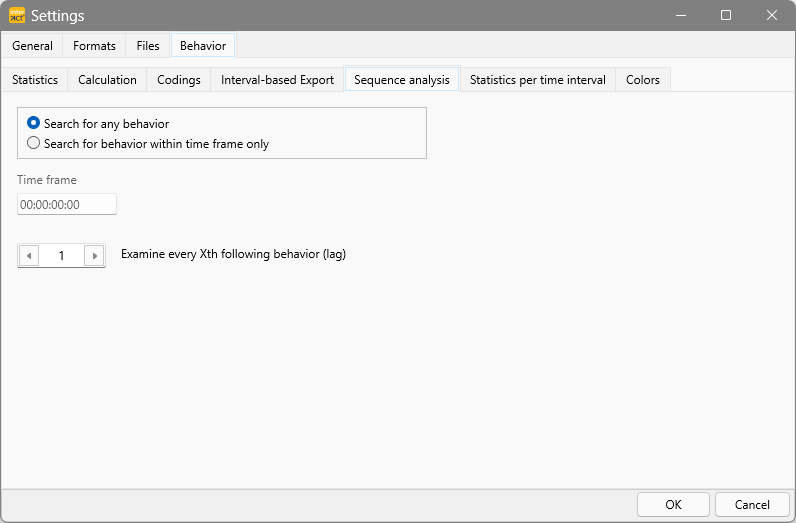If you have purchased a license for the Sequence Analysis add-on for INTERACT, the Timeline Chart also offers you the possibility to perform a Lag Sequential Analysis.
The Sequence analysis settings automatically appear if you run the Sequence Analysis routine. The settings can be predefined in the Program settings.
▪Click the General - Program - Settings ![]() .
.
▪Switch to the Behavior - Sequence analysis tab.

Search varieties
At the top of this dialog, you can choose between the following options:
•Search for any behavior - Any behavior that occurs next is counted (even if it happens 1 hour later)
•Search for behavior within a time frame - Only behavior occurring within the predefined time frame is counted.
If the second option is activated, the Time frame text box becomes active:
•Time frame - Enter the time frame that is appropriate for your study into the text box.
Lag definition
The second part of the dialog you can define the Lag in Examine every Xth following behavior.
The search is ALWAYS performed from onset to onset.
In the case of partially overlapping codes, this also results in sequences of partially simultaneously occurring events.
A sequence is therefore not necessarily something that takes place one after the other.
Lag = 1 - Starting with an Event (1), the system searches for the onset of the first subsequent Event (2). The combination 1 followed by 2 is counted as a sequence.
Lag = 2 - Starting with an Event (1), the system searches for the onset of the second subsequent Event (3); the Event with the first subsequent onset found is skipped. The combination of 1 followed by 3 is counted as a sequence.
Lag=3 - Starting with an Event (1), the system searches for the onset of the third subsequent Event (4); the Events with the first two subsequent onsets are skipped. The combination of 1 followed by 4 is counted as a sequence. Etc.
Example: A man is pushed around, he hits back and after that he hugs his opponent. With lag = 2 the pushing is followed by hugging.
IMPORTANT: Because the original LSA was developed for strictly continuously coded data, the results of adapting the lag distance might not be as expected.
INTERACT does not force you to code continuously so your data might not fit the original formula. We advise you to alternatively try the application GSEQ from Roger Bakeman. He also uses INTERACT and offers a converter for for INTERACT files on the website.
Calculation precision
If your data shows only little variance, or if you need higher accuracy during the calculation you can influence that as well:
▪Increase or reduce the Floating point precision during calculation value, for more or less decimal digits in the result table.